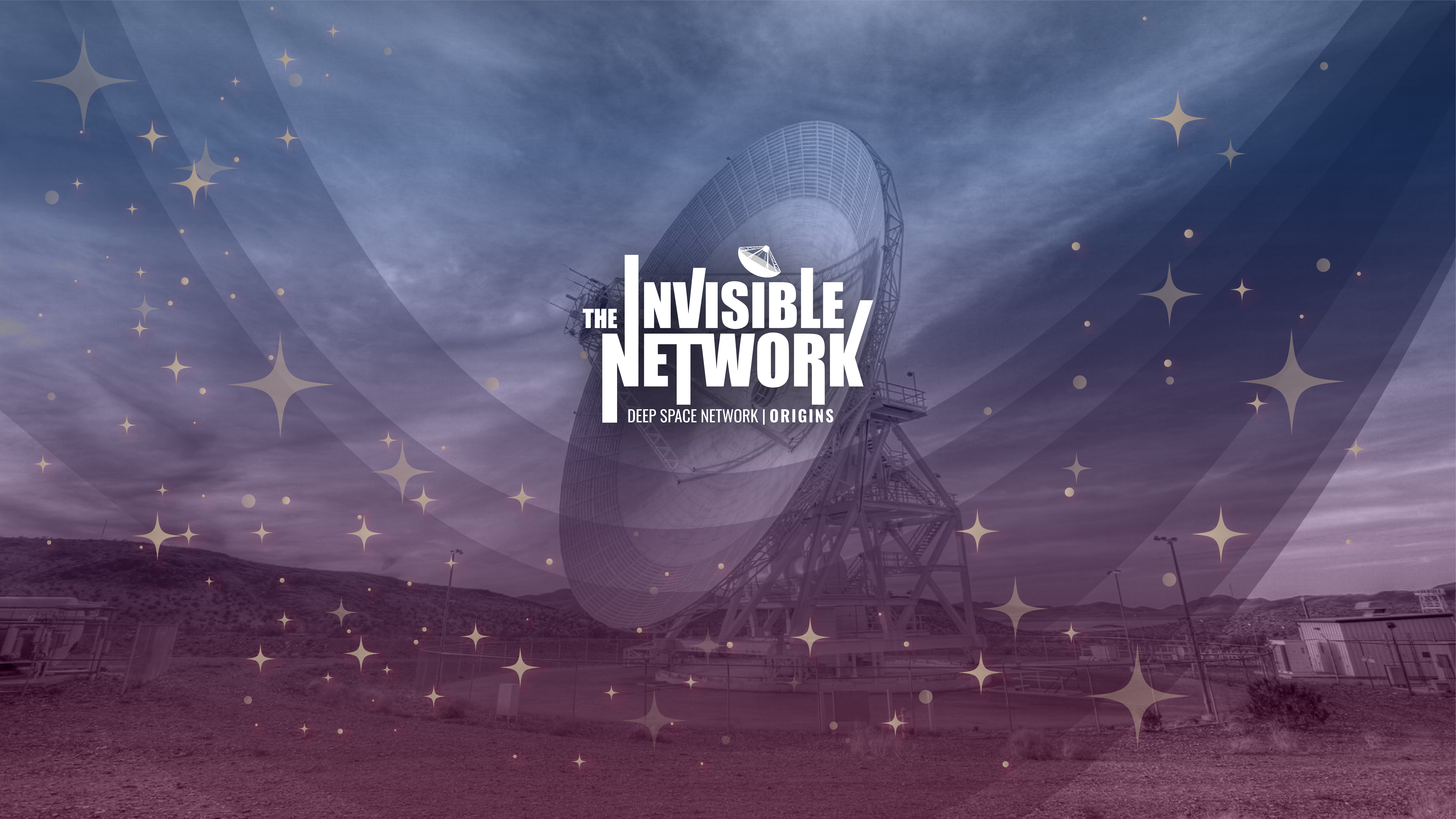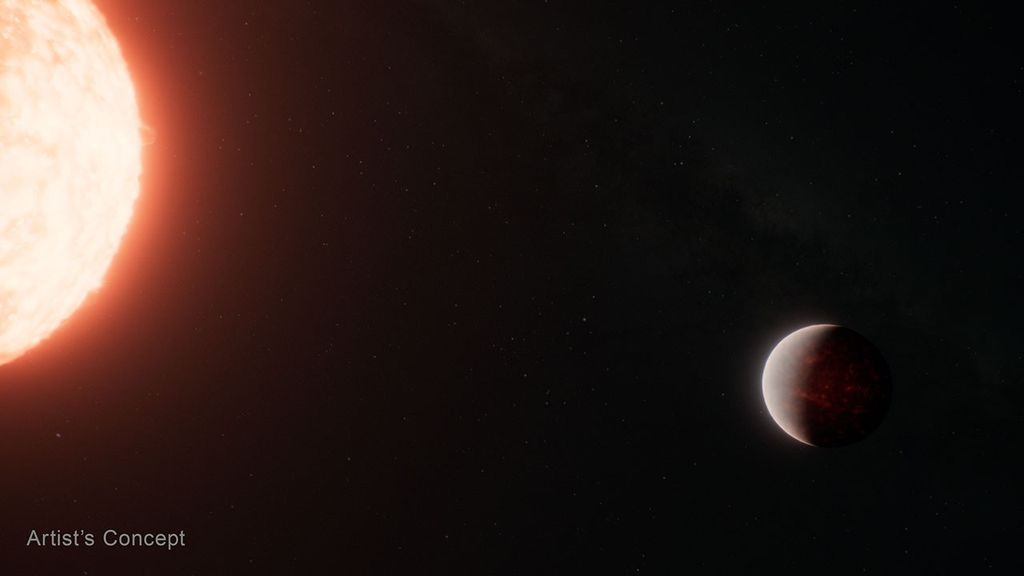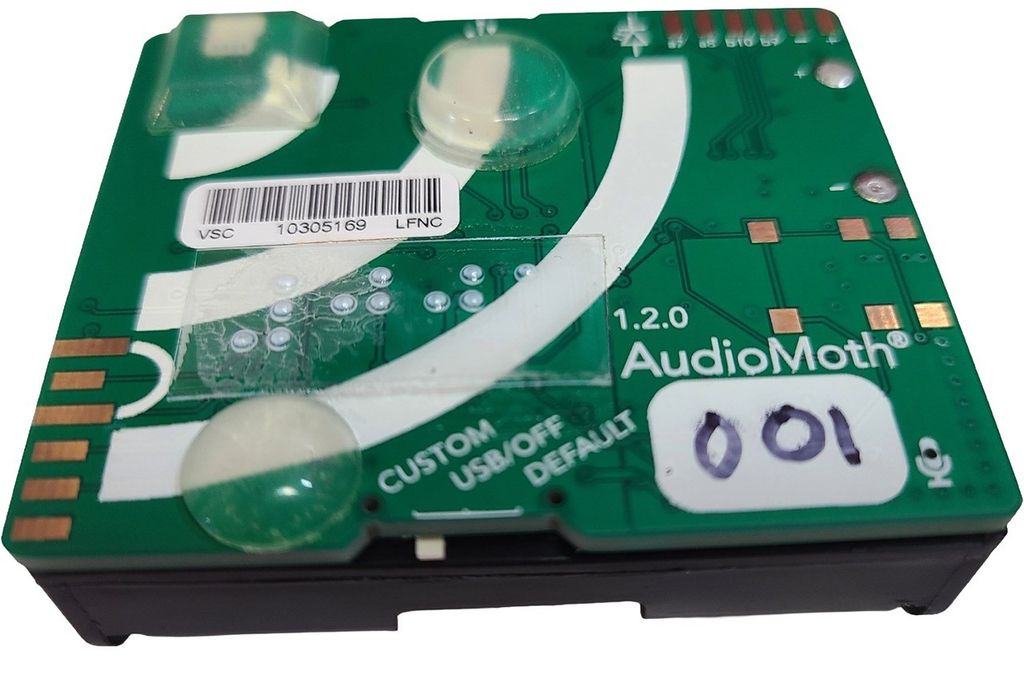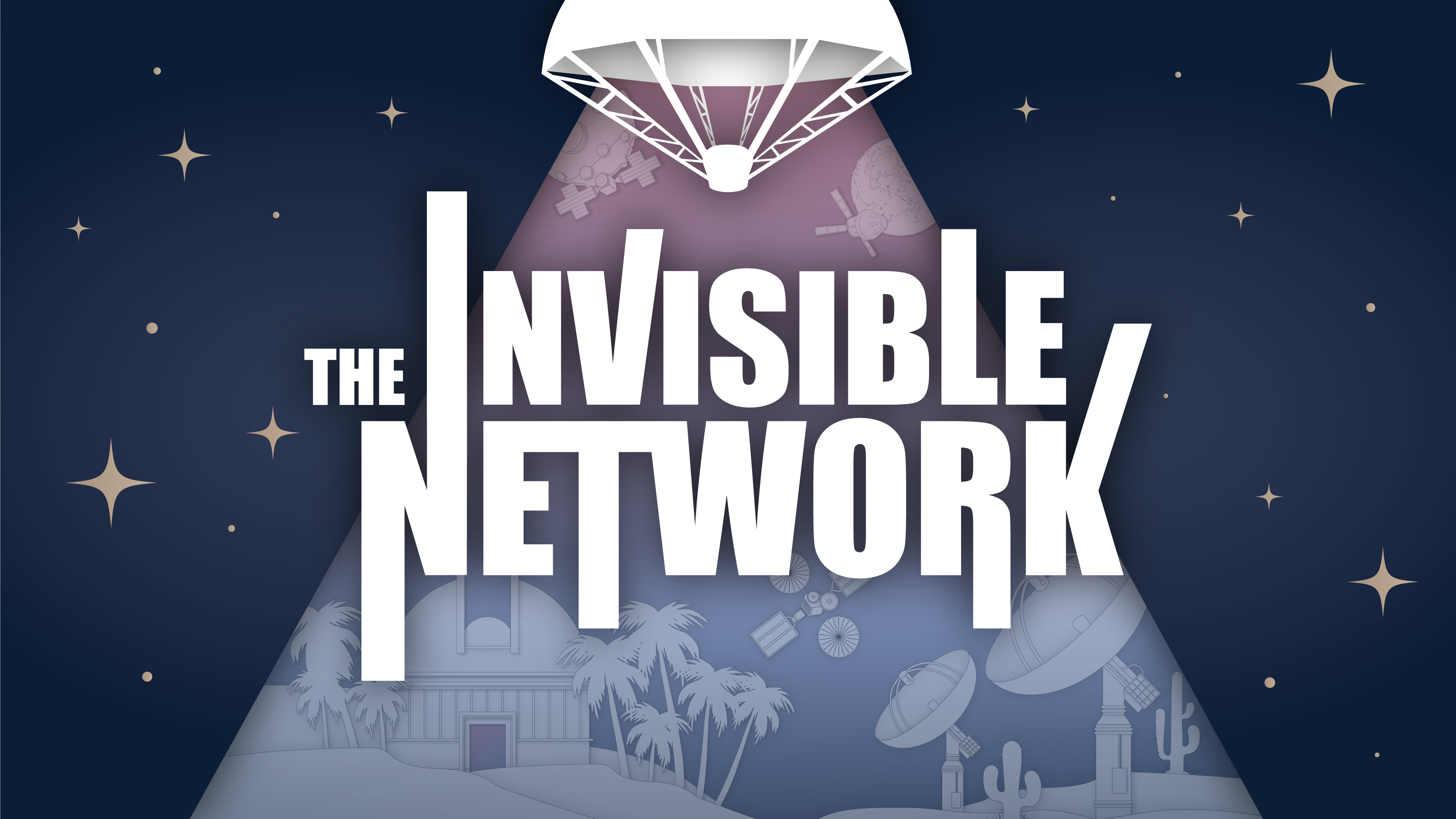
SUZANNE DODD
It started here in California, and it started as an Army antenna that was – in the late 50s – transferred to NASA when NASA was established.
BRAD ARNOLD
The DSN, it harkens back to, the very first spaceflight:…Explorer One, our first satellite that followed on the heels of Sputnik…
PHILIP BALDWIN
When you talk NASA… Deep Space Network has been there from the beginning… They carry that legacy and that history of NASA with them.
SUZANNE DODD
We have over 50 missions – either that we’re supporting, or are committed missions for us to support – and that requires a lot of assets.
Audio collage ends
…
NARRATOR
NASA is an agency made up of a myriad centers, programs, offices, contracts – all organized around a singular mission of science, discovery, and exploration.
The Jet Propulsion Laboratory has a particularly interesting place in the agency. In fact, JPL predates NASA itself. To get us started, here’s JPL’s Kathleen Harmon.
KATHLEEN HARMON
JPL… originated back in the 1930s and 40s as an offshoot of the California Institute of Technology, which is located in Pasadena.
NARRATOR
JPL’s origins began in the 1930s with the cutting-edge work in rocket propulsion of Caltech professor Theodore von Kármán – the same Kármán after which the indistinct boundary between Earth and space is named. Caltech graduate students moved their work off campus to a dry canyon wash – the Arroyo Seco – which later became the home of JPL.
KATHLEEN HARMON
Through those humble beginnings, Caltech did some rocket research, which eventually led to the Army getting interested in the 1940s when World War II came up. And once the war was over, 1950s came and NASA was formed, that area was transitioned.
NARRATOR
In 1958, after JPL and the Army Ballistic Missile Agency launched Explorer I – America’s first satellite – JPL transferred to NASA’s civil space jurisdiction, just two months after the agency began operations.
As this is a podcast about the ‘invisible networks’ that empower science and exploration, it shouldn’t surprise you that a discussion of JPL immediately turns to one of the most iconic pieces of NASA infrastructure: the Deep Space Network. Along with programs like Explorer, JPL’s Army antennas also transitioned to NASA for use by the newfound agency.
BRAD ARNOLD
My name is Brad Arnold, and I am the Deep Space Network project manager.
As the overall project manager, I’m responsible for the day-to-day operations and maintenance of the network, as well as sustainment and development tasks. It’s largely a programmatic role. So, I interface a lot with NASA, I deal with budgets, performance monitoring, staffing, planning. But occasionally I get to roll up my sleeves and get into some engineering topics.
NARRATOR
For starters though, Brad can share a little about the Deep Space Network’s origins:
BRAD ARNOLD
The DSN, it harkens back to, the very first spaceflight:…Explorer One, our first satellite that followed on the heels of Sputnik…
And since then, it’s been evolving to keep up with the demands of science, and of the missions, and technology. Back in the day, we would incorporate new antennas for very specific projects. So, if the Mariner series of spacecraft were going out, we would actually develop a set of antennas – one at each complex – to satisfy that mission. And it was very much matched to the mission at the time.
But, as the number of missions increased, and the lifespan of the missions increased, each antenna was then taking care of multiple missions. And we’ve kind of grown along that path.
NARRATOR
Despite its origins, the Deep Space Network is as much a part of NASA as any other NASA center, facility, project, program, or mission.
KATHLEEN HARMON
We’re all one NASA, right?
NARRATOR
Organizational structures aside, we are one NASA. But a good place to start a discussion about NASA network support is with the folks at the Space Communications and Navigation program, or SCaN, at NASA Headquarters in Washington, D.C.
PHILIP BALDWIN
My name is Philip Baldwin, and I am the SCaN operations manager. I guess the more formal title is: Network Operations Program Executive.
So what I do is: I oversee the operations and maintenance of the NASA communications networks and ensure that… we are providing that data to the missions. Getting data down, making sure that the systems are running well, and being reliable and proficient, and having that great success that we’ve had over the years.
NARRATOR
NASA organizes most of its space communications capabilities into two entities:
PHILIP BALDWIN
We have the Deep Space Network and the Near Space Network:
The Near Space Network is at Goddard. And they manage that that network…
For the Deep Space Network at JPL… they’ll do all the technical management, oversight, and the planning and the budgeting… and just looking at the future vision of where the Deep Space Network is going to go.
NARRATOR
But before we look at the future, we’ll look at the legacy of the Deep Space Network.
PHILIP BALDWIN
The Deep Space Network technically formed in 1963. And so, it’s been around for coming up on 60 years here. Wow, time goes by fast…
So, when you talk NASA, the Deep Space Network has been there from the beginning. And so really, they carry that legacy and that history of NASA with them.
The Invisible Network theme.
NARRATOR
NASA’s communications networks are the foundation of space exploration. The agency launches missions that capture immense amount of data – including images, videos, and insights that lead to breakthrough discoveries. Those data are then transferred back to Earth over invisible links to NASA’s global network of ground antennas.
Here on Earth, scientists and researchers use the data to better understand our planet, the solar system, and the universe. But none of that would be possible without these communications networks.
In this first episode of a season about NASA’s Deep Space Network, we examine the DSN’s evolution as we overview its basic structure and capabilities.
I’m Danny Baird. This is “The Invisible Network.”
A collage of historical audio
PRESIDENT JOHN F. KENNEDY
We choose to go to the Moon in this decade…
NEIL ARMSTRONG(Apollo 11)
That’s one small step for man…
COMMENTATOR(Voyager Launch)
We have ignition, and we have lift off!
CHILD FROM VOYAGER GOLDEN RECORDS
Hello from the children of planet earth…
COMMENTATOR(Cassini Launch)
Three… two… one… and liftoff, of the Cassini spacecraft…
COMMENTATOR(Perseverance Landing)
Touchdown confirmed, Perseverance safely on the surface of Mars…
Theme music fades.
SUZANNE DODD
My name is Suzanne Dodd. People call me Suzy. And I am the director for the Interplanetary Network Directorate at the Jet Propulsion Laboratory. And part of that directorate – what’s underneath it – is the Deep Space Network.
NARRATOR
The Interplanetary Network Directorate oversees space communications activities at JPL. That includes Deep Space Network operations and a host of technology development and science activities.
To clarify the organizational bits again:
SUZANNE DODD
JPL is NASA’s Federally Funded Research and Development Center, we call an FFRDC. So, it’s operated by Caltech. So, JPL is actually a division of the California Institute of Technology. NASA pays Caltech a fee to operate the Jet Propulsion Laboratory for them.
Both the Deep Space Network and the Near Space Network are under the Space Communications and Navigation organization at Headquarters.
NARRATOR
Now that that’s out of the way, let’s talk about the history of the DSN.
SUZANNE DODD
The early missions were… missions to the Moon and to places like Venus and Mercury… The early antennas were on the order of 26 meters and sometimes a little bit smaller and they were they were meant primarily for… distances to close planets. That’s what they did a lot in the 60s.
We also got involved with the Apollo Program, and so we built some antennas for the Apollo program back in the late 60s. And obviously, those were [crewed] missions to the Moon that we operated.
And I think as people got more ambitious with missions like [the] Viking lander…
NARRATOR
(The first spacecraft to successfully land on Mars.)
SUZANNE DODD
…and then Voyager itself, we built bigger antennas. And the 70-meter antennas are actually over 50 years old. They were the real workhorses – and continued to be the real workhorses – for deep space missions, anything out Jupiter and beyond.
NARRATOR
It’s hard to put the sizes of those antennas into context. When Suzanne mentions a 26-meter or a 70-meter antenna, she’s referring to the diameter of the antennas. A 26-meter antenna is around 85 feet in diameter, about as wide as Rome’s Trevi Fountain is tall. A 70-meter antenna is around 230 feet in diameter, almost as long as a Boeing 747 jumbo jet.
Suzanne works on those large antennas as well as the most distant mission they support: Voyager. The Voyager program consists of two robotic probes that launched in 1977 to study the outer planets: Jupiter, Saturn, Uranus, and Neptune.
SUZANNE DODD
I’ve been with JPL since 1984. When I went to school at Caltech – and when I first started at JPL – I started on the Voyager project during the Uranus and Neptune encounters. And the Voyager project is still going. They just passed the 44th launch anniversary.
And about 10 years ago, I was appointed to be the project manager of Voyager as well as my role as the director for the Interplanetary Network… Voyager and the Deep Space Network are really intertwined. You can’t talk about one without talking about the other because the Voyager spacecraft,…they’re both in interstellar space.
So to give you an example: the distance from the Earth? It’s about 14 billion miles for Voyager 1 and 12 billion miles for Voyager 2. It’s equivalent of five times the distance from Earth and Neptune.
And we use the Deep Space Network antennas to talk to Voyager. It’s the furthest object that the deep space antennas communicate with.
NARRATOR
To support the Voyager spacecraft in interstellar space, beyond the influence of our Sun may seem a complicated task, but the basic architecture of the DSN is relatively easy to understand. There are three locations, which we call “complexes,” that together can see pretty much the entire sky as the Earth turns. These complexes were strategically selected by JPL after looking at a wide variety of locations worldwide.
BRAD ARNOLD
We have one in Madrid, Spain; one in Canberra, Australia; and one in Goldstone, California… They’re geographically separated, about 120 degrees apart.
They’re in different countries. And so obviously, the culture and the people are different, and we all need to work together…
The weather is extremely different. One’s in the desert. One’s in a somewhat temperate, rainy area. And in Australia it’s kind of in between, but they have things like wildfires down there, and kangaroos. And it’s a very different environment.
SUZANNE DODD
Each complex has one very large 70-meter antenna, and then three 34-meter antennas. That’s the diameter of the antenna.
NARRATOR
The development of the 70-meter antennas themselves is a great example of how the Voyager missions and the Deep Space Network are so intertwined:
SUZANNE DODD
They started out as 64-meter antennas… then they got built out to 70-meter antennas for the Uranus encounter, because Uranus was so much further out than Jupiter and Saturn. So, they actually got expanded from 64-meters to 70-meters in [the] 1986 timeframe.
NARRATOR
One of my favorite things to ask folks working on the DSN is to explain the scale of these enormous, 70-meter antennas. Here’s Suzanne’s:
SUZANNE DODD
So, a 70-meter antenna: we have a nice little graphic that shows it sitting inside the Rose Bowl here in Pasadena and… you put it in the middle of the field, that pretty much takes up the whole stadium. So, 70 meters is very big and the 34s are like half that size.
NARRATOR
But why do we need such enormous antennas? Here’s Philip Baldwin again:
PHILIP BALDWIN
Because they’re large antennas that we have – the largest being the 70-meter antenna – we’re able to listen to faint signals from very, very far away. And we’re talking about very faint signals…
We used to use the comparison of: it’s like the power of a light bulb in your refrigerator, right? Of course, now light bulbs are LEDs, so it’s probably all different now. But back in the old days when he had the incandescent light bulb – about one watt – you can imagine transmitting that from millions of miles away and trying to get that signal.
SUZANNE DODD
The network is designed to track spacecraft that are in deep space. There’s lots of different definitions of deep space,…but the Deep Space Network antennas can really track anything from about geosynchronous orbit out…
NARRATOR
Geosynchronous orbit is about 22,000 miles from Earth, where many communications and weather satellites reside. The Deep Space Network is more focused on missions venturing much further afield.
BRAD ARNOLD
The DSN is the conduit of data from distant spacecraft to the mission scientists back here on Earth. And none of the missions would exist without it. So, we communicate through radio waves, and those radio waves are focused by antennas on the ground.
NARRATOR
The 70-meter antennas are the largest feature of each DSN complex. They’re specifically designed to detect weak radio signals from missions at the outer planets and interstellar space.
We often say that these antennas “listen” for transmissions, but — as I’ve learned from speaking with a DSN scientist we’ll hear more from later this season – the more appropriate term is “sees.” From a physics standpoint, the waves received by the Deep Space Network are no different from those received by telescopes like Hubble, James Webb, or those on Earth. Radio transmissions, infrared heat, and visible light from the Sun are all just different types of electromagnetic radiation.
It makes sense then that the DSN needs such large antennas to communicate with distant spacecraft. If you need an enormous optical telescope to take a picture of a distant gas giant, you’d need a similarly large radio antenna to receive a radio signal sent from a spacecraft there.
But sometimes, even the DSN’s enormous antennas aren’t enough. Then, the network employs an innovation called arraying.
SUZANNE DODD
A spacecraft might need more than a 70-meter. It might need a 70-meter and two 34s. So, all three of those antennas will point at a spacecraft, they’ll gather the data, and then we’ll compile and put that data together into one stream… The arraying is where you take the electronic signals from each of those antennas and combine them together to get a stronger strength signal.
NARRATOR
Alternately, if the 70-meter antenna is undergoing maintenance or busy with another mission, DSN ground stations can array their 34-meter antennas.
BRAD ARNOLD
So, we can point two, or three, or four antennas at one spacecraft and then digitally combine those signals. So, we can create a 70-meter out of four 34-meter antennas… that allows us some efficiency and some flexibility to handle more missions that need larger antennas.
NARRATOR
After receiving data from deep space, the network guides data from spacecraft to space scientist. The first leg is from space to ground, whether that’s direct-to-Earth or through a relay satellite orbiting Mars. Then the data flows to one central hub. From there, it’s disseminated to the missions.
SUZANNE DODD
The data will go to the central DSN processing center, which is here at JPL, and then it will get sent out all sorts of places… whosever mission it is, they have a mission operations center somewhere.
For JPL missions, that’s actually at JPL, so it’s quite simple. But there’s missions by Goddard, there’s university sponsored missions…
What we do at JPL in our processing centers: we do what’s called a level zero processing. In other words, it’s the basic bits. It’s not any of the interpretation of the bits. And so, the interpretation of what’s there in the data, the science interpretation is what the project mission operations centers do.
BRAD ARNOLD
We now service 39 missions, and some of them are very, very new, and some of them are very old. In 1977, the two Voyager spacecraft launched and they had the Grand Tour out past the big planets of Jupiter and Saturn, Uranus and Neptune. And long after they did those flybys, those two spacecraft are still operating. And we’re still tracking them today.
But in the meantime, we’ve picked up a lot of other new missions, and some have come and gone. We’re currently tracking 39 and we’ve got 30 more coming… which is super exciting, but it’s also very daunting.
PHILIP BALDWIN
We do a lot of support of missions that are not NASA. There’s ESA [the European Space Agency], Korea, JAXA [the Japanese Space Agency]…
It’s a world-class network. And so, a lot of other agencies have modeled their systems based on DSN because it’s been around so long and has been so successful. So, we’ve supported them, and we support other missions, and the international partnership has been great.
…
The Invisible Network theme.
NARRATOR
The very name of this podcast speaks to the oft overlooked nature of NASA’s networks. While pieces of the Deep Space Network has been around longer than the agency itself, there’s still much about the DSN that’s invisible to many.
SUZANNE DODD
Sometimes I feel like we’re the roads… The sexy new spacecraft get all the attention, but they would get no data… if the Deep Space Network wasn’t working. Similar to the fancy new car: it’s not going to get anywhere if the roads are full of potholes. So, we are definitely a critical piece of infrastructure to all the great images that you see from Mars and other planets.
NARRATOR
Much as the roads we drive on every day are key to our lives but taken for granted, the Deep Space Network is critical to our continued exploration of space. Despite its age:
It’s robust.
It’s reliable.
It’s trusted.
As we progress through this season’s six episodes, we’ll meet some of the individuals that keep it so. And together, we can render the network a little less invisible.
Thank you for listening. Do you want to connect with us? The Invisible Network team is collecting questions about NASA’s Deep Space Network from listeners like you! We’re putting together a panel of NASA experts from across the Space Communications and Navigation community to answer your questions.
If you would like to participate, navigate over to NASA SCaN on Twitter or Facebook and ask your question using the hashtag AskSCaN. That’s @ NASA SCaN, N-A-S-A-S-C-A-N, on social media, with the hashtag AskSCaN, A-S-K-S-C-A-N.
This Deep Space Network-focused season of “The Invisible Network” debuted in summer of 2022. Developed by NASA’s Jet Propulsion Laboratory in Southern California, the Deep Space Network is managed by JPL with funding and strategic oversight from the Space Communications and Navigation, or SCaN, program at NASA Headquarters in Washington, D.C.
This podcast is produced by SCaN at NASA’s Goddard Space Flight Center in Greenbelt, Maryland, with episodes written and recorded by me, Danny Baird. Editorial support is provided by Katherine Schauer and JPL’s Laurance Fauconnet. Our public affairs officer is Lora Bleacher.
Special thanks to Fall 2021 interns Julia Adde and Nate Thomas, Barbara Adde, SCaN Policy and Strategic Communications director, and all those who have lent their time, talent, and expertise to making “The Invisible Network” a reality. Be sure to rate, review, and follow the show wherever you get your podcasts.
For transcripts of episodes, visit NASA.gov/invisible. To learn more about the vital role that space communications plays in NASA’s mission, visit NASA.gov/SCaN. For more NASA podcast offerings, visit NASA.gov/podcasts. There, you can check out “On a Mission,” the official podcast of NASA’s Jet Propulsion Laboratory.


























